+ Open data
Open data
- Basic information
Basic information
| Entry | Database: PDB / ID: 8fyn | |||||||||
|---|---|---|---|---|---|---|---|---|---|---|
| Title | MicroED structure of A2A from plasma milled lamellae | |||||||||
 Components Components | Adenosine receptor A2a,Soluble cytochrome b562 | |||||||||
 Keywords Keywords | MEMBRANE PROTEIN / A2A Adenosine Receptor | |||||||||
| Function / homology |  Function and homology information Function and homology informationpositive regulation of acetylcholine secretion, neurotransmission / positive regulation of circadian sleep/wake cycle, sleep / regulation of norepinephrine secretion / negative regulation of alpha-beta T cell activation / Adenosine P1 receptors / G protein-coupled adenosine receptor activity / G protein-coupled adenosine receptor signaling pathway / response to purine-containing compound / sensory perception / positive regulation of urine volume ...positive regulation of acetylcholine secretion, neurotransmission / positive regulation of circadian sleep/wake cycle, sleep / regulation of norepinephrine secretion / negative regulation of alpha-beta T cell activation / Adenosine P1 receptors / G protein-coupled adenosine receptor activity / G protein-coupled adenosine receptor signaling pathway / response to purine-containing compound / sensory perception / positive regulation of urine volume / NGF-independant TRKA activation / Surfactant metabolism / synaptic transmission, dopaminergic / : / inhibitory postsynaptic potential / negative regulation of vascular permeability / synaptic transmission, cholinergic / type 5 metabotropic glutamate receptor binding / positive regulation of glutamate secretion / blood circulation / response to caffeine / intermediate filament / eating behavior / presynaptic active zone / alpha-actinin binding / membrane depolarization / regulation of calcium ion transport / asymmetric synapse / axolemma / : / cellular defense response / prepulse inhibition / phagocytosis / response to amphetamine / presynaptic modulation of chemical synaptic transmission / excitatory postsynaptic potential / positive regulation of synaptic transmission, glutamatergic / neuron projection morphogenesis / regulation of mitochondrial membrane potential / synaptic transmission, glutamatergic / positive regulation of long-term synaptic potentiation / locomotory behavior / central nervous system development / astrocyte activation / positive regulation of synaptic transmission, GABAergic / positive regulation of protein secretion / apoptotic signaling pathway / electron transport chain / positive regulation of apoptotic signaling pathway / adenylate cyclase-modulating G protein-coupled receptor signaling pathway / adenylate cyclase-activating G protein-coupled receptor signaling pathway / negative regulation of inflammatory response / vasodilation / blood coagulation / cell-cell signaling / presynaptic membrane / G alpha (s) signalling events / postsynaptic membrane / negative regulation of neuron apoptotic process / periplasmic space / electron transfer activity / calmodulin binding / response to xenobiotic stimulus / inflammatory response / iron ion binding / negative regulation of cell population proliferation / neuronal cell body / glutamatergic synapse / lipid binding / apoptotic process / dendrite / heme binding / protein-containing complex binding / regulation of DNA-templated transcription / enzyme binding / identical protein binding / membrane / plasma membrane Similarity search - Function | |||||||||
| Biological species |  Homo sapiens (human) Homo sapiens (human) | |||||||||
| Method | ELECTRON CRYSTALLOGRAPHY / electron crystallography / cryo EM / Resolution: 2 Å | |||||||||
 Authors Authors | Martynowycz, M.W. / Shiriaeva, A. / Clabbers, M.T.B. / Nicolas, W.J. / Weaver, S.J. / Hattne, J. / Gonen, T. | |||||||||
| Funding support |  United States, 2items United States, 2items
| |||||||||
 Citation Citation |  Journal: Nat Commun / Year: 2023 Journal: Nat Commun / Year: 2023Title: A robust approach for MicroED sample preparation of lipidic cubic phase embedded membrane protein crystals. Authors: Michael W Martynowycz / Anna Shiriaeva / Max T B Clabbers / William J Nicolas / Sara J Weaver / Johan Hattne / Tamir Gonen /  Abstract: Crystallizing G protein-coupled receptors (GPCRs) in lipidic cubic phase (LCP) often yields crystals suited for the cryogenic electron microscopy (cryoEM) method microcrystal electron diffraction ...Crystallizing G protein-coupled receptors (GPCRs) in lipidic cubic phase (LCP) often yields crystals suited for the cryogenic electron microscopy (cryoEM) method microcrystal electron diffraction (MicroED). However, sample preparation is challenging. Embedded crystals cannot be targeted topologically. Here, we use an integrated fluorescence light microscope (iFLM) inside of a focused ion beam and scanning electron microscope (FIB-SEM) to identify fluorescently labeled GPCR crystals. Crystals are targeted using the iFLM and LCP is milled using a plasma focused ion beam (pFIB). The optimal ion source for preparing biological lamellae is identified using standard crystals of proteinase K. Lamellae prepared using either argon or xenon produced the highest quality data and structures. MicroED data are collected from the milled lamellae and the structures are determined. This study outlines a robust approach to identify and mill membrane protein crystals for MicroED and demonstrates plasma ion-beam milling is a powerful tool for preparing biological lamellae. | |||||||||
| History |
|
- Structure visualization
Structure visualization
| Structure viewer | Molecule:  Molmil Molmil Jmol/JSmol Jmol/JSmol |
|---|
- Downloads & links
Downloads & links
- Download
Download
| PDBx/mmCIF format |  8fyn.cif.gz 8fyn.cif.gz | 330.9 KB | Display |  PDBx/mmCIF format PDBx/mmCIF format |
|---|---|---|---|---|
| PDB format |  pdb8fyn.ent.gz pdb8fyn.ent.gz | 229.9 KB | Display |  PDB format PDB format |
| PDBx/mmJSON format |  8fyn.json.gz 8fyn.json.gz | Tree view |  PDBx/mmJSON format PDBx/mmJSON format | |
| Others |  Other downloads Other downloads |
-Validation report
| Summary document |  8fyn_validation.pdf.gz 8fyn_validation.pdf.gz | 1.4 MB | Display |  wwPDB validaton report wwPDB validaton report |
|---|---|---|---|---|
| Full document |  8fyn_full_validation.pdf.gz 8fyn_full_validation.pdf.gz | 1.4 MB | Display | |
| Data in XML |  8fyn_validation.xml.gz 8fyn_validation.xml.gz | 20.4 KB | Display | |
| Data in CIF |  8fyn_validation.cif.gz 8fyn_validation.cif.gz | 28.9 KB | Display | |
| Arichive directory |  https://data.pdbj.org/pub/pdb/validation_reports/fy/8fyn https://data.pdbj.org/pub/pdb/validation_reports/fy/8fyn ftp://data.pdbj.org/pub/pdb/validation_reports/fy/8fyn ftp://data.pdbj.org/pub/pdb/validation_reports/fy/8fyn | HTTPS FTP |
-Related structure data
| Related structure data |  29586MC  8fyoC  8fypC  8fyqC  8fyrC  8fysC M: map data used to model this data C: citing same article ( |
|---|---|
| Similar structure data | Similarity search - Function & homology  F&H Search F&H Search |
- Links
Links
- Assembly
Assembly
| Deposited unit | 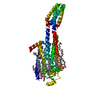
| ||||||||||||
|---|---|---|---|---|---|---|---|---|---|---|---|---|---|
| 1 |
| ||||||||||||
| Unit cell |
| ||||||||||||
| Components on special symmetry positions |
|
- Components
Components
-Protein , 1 types, 1 molecules A
| #1: Protein | Mass: 49974.281 Da / Num. of mol.: 1 Source method: isolated from a genetically manipulated source Source: (gene. exp.)  Homo sapiens (human) / Gene: ADORA2A, ADORA2, cybC Homo sapiens (human) / Gene: ADORA2A, ADORA2, cybCProduction host:  Spodoptera aff. frugiperda 1 BOLD-2017 (butterflies/moths) Spodoptera aff. frugiperda 1 BOLD-2017 (butterflies/moths)References: UniProt: P29274, UniProt: P0ABE7 |
|---|
-Non-polymers , 7 types, 200 molecules 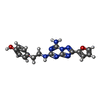

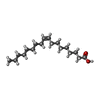
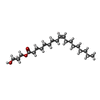
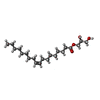








| #2: Chemical | ChemComp-ZMA / | ||||||||||
|---|---|---|---|---|---|---|---|---|---|---|---|
| #3: Chemical | | #4: Chemical | ChemComp-OLA / #5: Chemical | ChemComp-OLC / ( #6: Chemical | ChemComp-OLB / ( | #7: Chemical | ChemComp-NA / | #8: Water | ChemComp-HOH / | |
-Details
| Has ligand of interest | N |
|---|
-Experimental details
-Experiment
| Experiment | Method: ELECTRON CRYSTALLOGRAPHY |
|---|---|
| EM experiment | Aggregation state: 3D ARRAY / 3D reconstruction method: electron crystallography |
- Sample preparation
Sample preparation
| Component | Name: A2A BRIL Adenosine receptor / Type: COMPLEX / Entity ID: #1 / Source: NATURAL |
|---|---|
| Molecular weight | Value: 0.041 MDa / Experimental value: NO |
| Source (natural) | Organism:  Homo sapiens (human) Homo sapiens (human) |
| Buffer solution | pH: 4.7 |
| Specimen | Conc.: 25 mg/ml / Embedding applied: NO / Shadowing applied: NO / Staining applied: NO / Vitrification applied: YES / Details: Milled microcrystals |
| Specimen support | Grid type: Quantifoil R2/2 |
| Vitrification | Instrument: LEICA PLUNGER / Cryogen name: ETHANE / Humidity: 95 % / Chamber temperature: 277 K |
-Data collection
| Experimental equipment |  Model: Titan Krios / Image courtesy: FEI Company |
|---|---|
| Microscopy | Model: FEI TITAN KRIOS |
| Electron gun | Electron source:  FIELD EMISSION GUN / Accelerating voltage: 300 kV / Illumination mode: FLOOD BEAM FIELD EMISSION GUN / Accelerating voltage: 300 kV / Illumination mode: FLOOD BEAM |
| Electron lens | Mode: DIFFRACTION / Nominal defocus max: 0 nm / Nominal defocus min: 0 nm / Cs: 2.7 mm / C2 aperture diameter: 50 µm / Alignment procedure: BASIC |
| Specimen holder | Cryogen: NITROGEN / Specimen holder model: FEI TITAN KRIOS AUTOGRID HOLDER / Temperature (max): 90 K / Temperature (min): 77 K |
| Image recording | Average exposure time: 0.5 sec. / Electron dose: 0.001 e/Å2 / Film or detector model: FEI FALCON IV (4k x 4k) / Num. of diffraction images: 840 / Num. of grids imaged: 1 / Num. of real images: 1 |
| Image scans | Sampling size: 28 µm / Width: 2048 / Height: 2048 |
| EM diffraction | Camera length: 1202 mm / Tilt angle list: -30,30 |
| EM diffraction shell | Resolution: 0.87→0.9 Å / Fourier space coverage: 37.64 % / Multiplicity: 2.1 / Num. of structure factors: 2783 / Phase residual: 30 ° |
| EM diffraction stats | Fourier space coverage: 87.58 % / High resolution: 0.87 Å / Num. of intensities measured: 569407 / Num. of structure factors: 64974 / Phase error: 30 ° / Phase error rejection criteria: None / Rmerge: 0.236 / Rsym: 0.073 |
| Reflection | Biso Wilson estimate: 12.54 Å2 |
- Processing
Processing
| Software |
| ||||||||||||||||||||||||||||||||||||||||||||||||||||||||||||||||||||||
|---|---|---|---|---|---|---|---|---|---|---|---|---|---|---|---|---|---|---|---|---|---|---|---|---|---|---|---|---|---|---|---|---|---|---|---|---|---|---|---|---|---|---|---|---|---|---|---|---|---|---|---|---|---|---|---|---|---|---|---|---|---|---|---|---|---|---|---|---|---|---|---|
| EM software | Name: AIMLESS / Category: crystallography merging | ||||||||||||||||||||||||||||||||||||||||||||||||||||||||||||||||||||||
| Image processing | Details: Binned by 2 | ||||||||||||||||||||||||||||||||||||||||||||||||||||||||||||||||||||||
| EM 3D crystal entity | ∠α: 90 ° / ∠β: 90 ° / ∠γ: 90 ° / A: 39.08 Å / B: 177.51 Å / C: 139.29 Å / Space group name: 20 / Space group num: 20 | ||||||||||||||||||||||||||||||||||||||||||||||||||||||||||||||||||||||
| CTF correction | Type: NONE | ||||||||||||||||||||||||||||||||||||||||||||||||||||||||||||||||||||||
| 3D reconstruction | Resolution: 2 Å / Resolution method: DIFFRACTION PATTERN/LAYERLINES / Algorithm: FOURIER SPACE / Symmetry type: 3D CRYSTAL | ||||||||||||||||||||||||||||||||||||||||||||||||||||||||||||||||||||||
| Atomic model building | B value: 12.54 / Protocol: AB INITIO MODEL / Space: RECIPROCAL / Target criteria: Maximum likelihood | ||||||||||||||||||||||||||||||||||||||||||||||||||||||||||||||||||||||
| Refinement | Resolution: 2→41.14 Å / SU ML: 0.2918 / Cross valid method: FREE R-VALUE / σ(F): 1.33 / Phase error: 28.6157 Stereochemistry target values: GeoStd + Monomer Library + CDL v1.2
| ||||||||||||||||||||||||||||||||||||||||||||||||||||||||||||||||||||||
| Solvent computation | Shrinkage radii: 0.6 Å / VDW probe radii: 0.9 Å / Solvent model: FLAT BULK SOLVENT MODEL | ||||||||||||||||||||||||||||||||||||||||||||||||||||||||||||||||||||||
| Displacement parameters | Biso mean: 23.1 Å2 | ||||||||||||||||||||||||||||||||||||||||||||||||||||||||||||||||||||||
| Refinement step | Cycle: LAST / Resolution: 2→41.14 Å
| ||||||||||||||||||||||||||||||||||||||||||||||||||||||||||||||||||||||
| Refine LS restraints |
| ||||||||||||||||||||||||||||||||||||||||||||||||||||||||||||||||||||||
| LS refinement shell |
|
 Movie
Movie Controller
Controller








 PDBj
PDBj






















